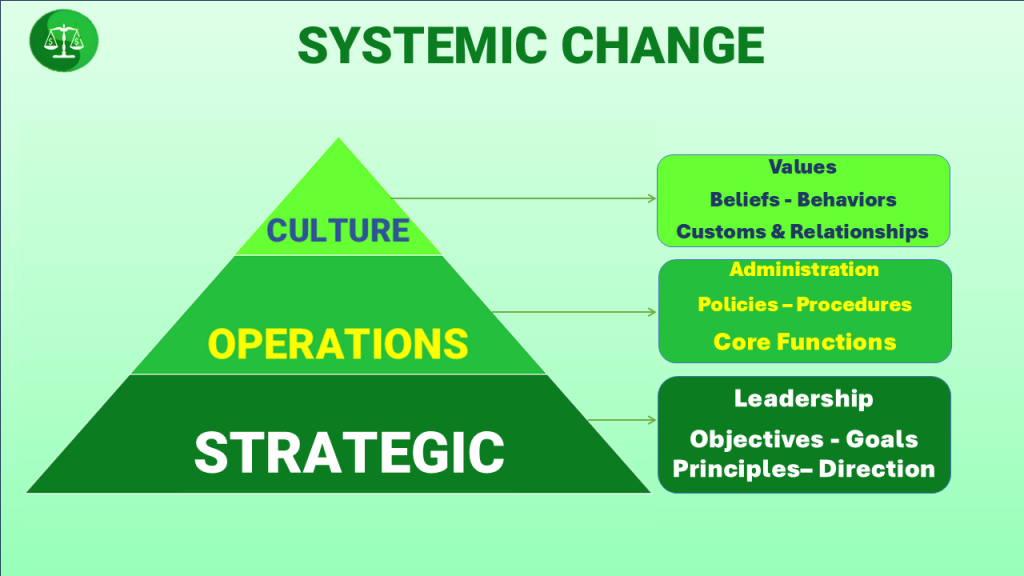WHAT IS SYSTEMIC CHANGE?
In the face of mounting global challenges, the need for transformational change has never been more apparent. It is imperative that we adopt a comprehensive and integrated approach to organizational and social transformation, one that addresses the root causes of challenges and paves the way for a sustainable future. This approach is known as Systemic Change.
At its core, Systemic Change is a structured process guided by a sequence of analytic procedures. It empowers Change Agents to lead transformation initiatives effectively. By following a systematic path, Systemic Change aims to:
Define and Confirm the Need for Change: This initial step involves a thorough examination of the current situation. It requires a deep understanding of the challenges at hand and a clear recognition of the urgency and scope of the transformation project.
Identify Root Causes: Systemic Change demands a rigorous analysis to identify the fundamental causes of obstacles and challenges. This step is critical in ensuring that the transformation addresses the underlying issues rather than merely surface-level symptoms.
Select the Best Solution Options: With a clear understanding of the challenges and their root causes, Change Agents can then identify the most appropriate solutions. These solutions must be aligned with the organization’s overarching objectives and the broader goals of sustainability and social justice.
Develop and Commit to a Transformation Plan: A well-defined plan is the blueprint for any successful transformation. It outlines the strategies, activities, roles, responsibilities, and timelines necessary for the execution of the change initiative.
Implement the Transformation Plan: Execution is where the transformation comes to life. This phase demands precise coordination, effective communication, and a keen eye for detail. Change Agents, along with designated Change Leaders, oversee the execution of projects and programs critical to achieving the transformation objectives.
One of the pivotal considerations in Systemic Change is determining the implementation priority. Classifying the nature of the challenge is critical in identifying the appropriate transformation approach.
CONCEPT

Systemic Change recognizes that organizations operate within three interconnected domains: Strategic, Operations, and Culture.
Strategic Change: This domain focuses on policy, directional, structural, and leadership issues that may hinder the achievement of organizational goals and objectives.
Operational Change: Here, the emphasis is on work processes, technical aspects, logistical considerations, and resource management practices that impact organizational performance.
Cultural Change: This domain delves into the values, beliefs, common practices, and behavioral norms that may impede progress toward desired goals.
The success of any transformation project hinges on the effective integration of strategic, cultural, and operational modifications guided by the scope, scale, and urgency of the issue at hand.
Change Management, the discipline of planning and executing organizational transformation, is instrumental in Systemic Change. While various change models exist, each with its unique strengths, it is crucial that the selected model encompasses all relevant components for the specific change project.
Regardless of the model chosen, certain fundamental principles remain constant:
Three States of Change: Every change process encompasses the current state, the transition state, and the future state. Understanding and navigating these states are critical to successful transformation.
Three Phases of Change Management: Defining, planning, and executing constitute the three core phases of a change management process. Each phase demands specific strategies and considerations.
Types of Change: Change can be radical and immediate, incremental, or gradual. The nature of the change informs the approach taken.
Consideration of Resistance: Recognizing and addressing resistance to change is paramount. Change Agents must be adept at identifying and neutralizing sources of resistance.
In Systemic Change, we introduce the Three Stages of Systemic Solutions:
- Assessment: Thoroughly analyze all factors impacting the project, including legal, political, economic, social, environmental, and technological considerations Consider and analyze all available information to determine: – If there is a definite need for change – What are the factors Driving the need for change (root causes) – what are best solution options? At the end of this stage, the transformation team should have a defined clear, and collective understanding of the purpose, the challenges, the objectives, and the strategic approach to the transformation exercise. This stage lays the foundation for the transformation journey and culminates in a clear Vision Statement that provides the necessary
- Planning: Develop a comprehensive transformation plan encompassing – new policies arising out of new strategies and/or external influences – new administrative procedures arising out of new policies, – new operational processes arising out of new policies and procedures, – critical success factors, – financial considerations, schedule of activities, roles, and assignments, and quality controls. This plan serves as the roadmap for the execution phase.
- Execution: The execution, phase involves two stages – Implementing the transformation projects and programs that will address the changes required in the three (3) realms of organizational management Strategic/Administrative Change, – Operational Changes, and/or Cultural and people-related challenges. The second phase involves ongoing Monitoring, Measuring, and modifying of established performance standards and targets to evaluate the success of the initiative. Ongoing evaluation allows for adjustments to the plan as the project progresses. Effective communication, conflict resolution, resource management, and competency assessment are crucial in this phase.
In conclusion, Systemic Change stands as a pragmatic and comprehensive model for effecting meaningful transformation. By addressing challenges at their roots and considering the interconnected domains of Strategy, Operations, and Culture, Change Agents pave the way for sustainable and impactful change. Embracing the principles of Change Management and understanding the stages and phases of change are crucial to the success of any transformation initiative. Through Systemic Change, we embark on a journey towards a more equitable, just, and sustainable future.
Tony Redman
A4C Sustainable Solutions Partners

CONSCIOUS VIBES CREATIONS
by A4C
Our Line of quality garments and accessories, feature positive social messages, to influence positive change! Hoodies, Sweaters, Baseball Caps, Water Battles, Mugs and more.

BLUETTI SUSTAINABLE PRODUCTS
At A4C, we promote proactive steps to mitigate the impacts of extreme climate occurrences. Those of us in the northern hemisphere must prepare for extreme cold and potential power outages. BLUETTI is the web's #1 choice for the high-quality portable power station, and emergency power equipment.

ACTION HEAT SUSTAINABLE PRODUCTS
Action Heat is the most complete and versatile heated clothing brand on the market. Experts in heated apparel, with 10+ years in the heated clothing category;Action Heat has tested, worn, and played with every heated garment on the market. Action Heat is the perfect blend of quality, performance, and price.

SYLVANE SUSTAINABLE PRODUCTS
Sylvane offers a wide selection of air quality and air treatment products from leading brands in the industry. Customers are supported with in-depth information and buying guides for all of our products which include: air purifiers, dehumidifiers, air conditioners, humidifiers, and heaters.
